Thinking of traveling to Spain and wondering what are the top experiences not to miss on your first visit? In this guide, we share some of the VERY BEST things to do in Spain for your bucket list. Find out!
You may have heard that Spain is the second most visited country in the world (after France). In fact, here in Europe, many families visit Spain year after year, generation after generation, and never even consider another destination…
But what is it that makes this country so fascinating? And where to go and what to do in order to experience the very best that Spain has to offer?
Spain is a huge country with a rich, centuries-old history and a wide diversity of landscapes and unique cultural experiences. As you can imagine, there are hundreds of amazing places to visit and thousands of interesting things to do in Spain.
Since no list – no matter how long – could ever do this country justice, there’s no point in writing an article with 79 or even 9999 things to do in Spain… After all, there’s no way you could see it all in one or even dozens of trips…
So this guide simply aims to showcase some of the top places and bucket list experiences in Spain and spark your interest. By showing different facets of this fascinating country, we hope to inspire you to visit Spain and explore it a bit deeper, beyond the main landmarks of Barcelona which is often the first and only stop for most first-time visitors. (And yes, Barcelona is absolutely worth it, but there’s so much more to see and experience in Spain!).
Good to know: This guide is published with the help and tips of Patricia Palacios, a Spanish travel writer and the founder of España Guide. Passionate about her country, she shares some of the most beautiful places and fantastic experiences in Spain hoping to inspire you to visit and get to know it first-hand.
Here are some of the bucket-list experiences, best things to do in Spain:
1. Visit the Alhambra Palace in Granada
If you could only visit one site in all of Spain, it should be the Alhambra Palace. It’s located in Granada in the Andalusia region in the south of the country. The complex and its gardens were built by the Moorish civilization of Al-Ándalus which occupied the area from the 9th til the 15th centuries.
The buildings are adorned with intricate plaster patterns and mesmerizing mosaic tiles. And since it was continually expanded over several hundreds of years, the place is huge! You could easily spend an entire day exploring patio after patio and the lush gardens.
The Moors were expelled from Granada in 1492. King Ferdinand and Queen Isabella were quick to move into the palaces. When you visit the Alhambra, you can even see the room where it is purported that Christopher Columbus came before them, to ask for the backing of his expedition to India. It is such an exotic juxtaposition to imagine these Christian monarchs sitting on their thrones in an opulent building that looks like it should be somewhere in the Middle East.
TIP: Since Alhambra tickets are limited, make sure you book in advance – even months in advance if you are visiting in the peak season. We also highly recommend taking part in a guided tour. There is just so much history and detail that can be missed if you don’t have someone to point it out to you.
INSIDER TIP: After a long day wandering through the palaces and gardens of the Alhambra, take a relaxing break at the Al-Ándalus Hammam (Arab baths).
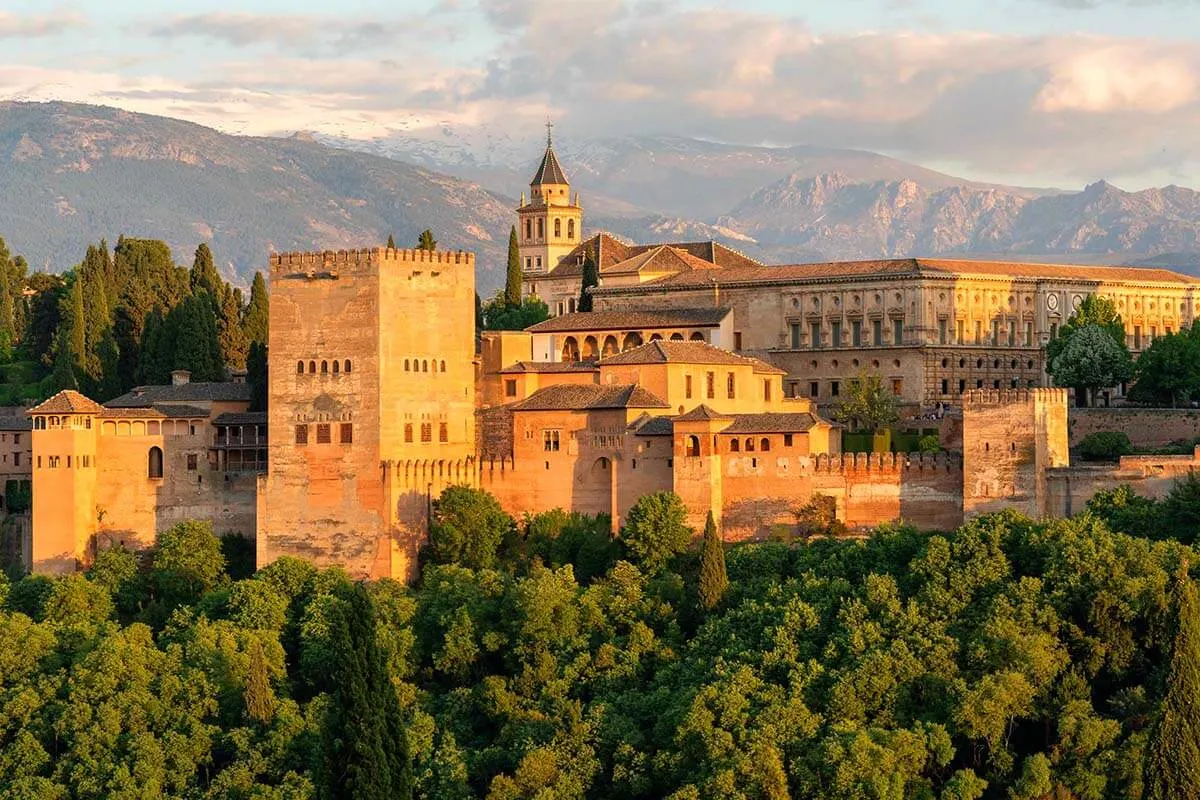
2. Explore Gaudí’s Barcelona
Antoni Gaudí (1852-1926) was the Spanish architect at the forefront of the Catalan Modernism movement. He is known for his unorthodox and organic-looking creations and timeless architectural wonders that continue to inspire many generations.
Barcelona was Gaudí’s muse and the mark he left on the city is admired all over the world. Seven of Gaudi’s buildings are designated as UNESCO World Heritage sites. Even if you have never been to Barcelona, you would likely recognize many of the landmarks designed by Gaudí.
No trip to Barcelona (or Spain, for that matter) would be complete without seeing Gaudi’s La Sagrada Familia Church. Gaudi dedicated his life to this remarkable project that began in 1882 and is yet to be completed. It is a one-of-a-kind masterpiece that is best described as a combination of Gothic and Art Nouveau shapes with some extra curviness thrown in for good measure. P.S.: no picture can capture the beauty, light, colors, or emotion you perceive when visiting this place.
In addition, there are many more of Gaudi’s masterpieces that you have to see in Barcelona! Park Güell and Casa Batlló are absolute must-sees, but we also recommend visiting La Pedrera-Casa Milà, Güell Palace, and Casa Vicens. If you have more time, visit the Church of Colònia Güell outside the city too!
TIP: Since Gaudi sights are extremely popular, it’s essential to book your tickets in advance, especially for La Sagrada Familia (+ the towers), Park Güell, and Casa Batlló. Also, here, we recommend going with a guide. There’s just so much symbolism and hidden meaning behind the architectural elements that you get a completely different insight going with a guide rather than just looking around.
LEARN MORE: Best Gaudi Tour in Barcelona
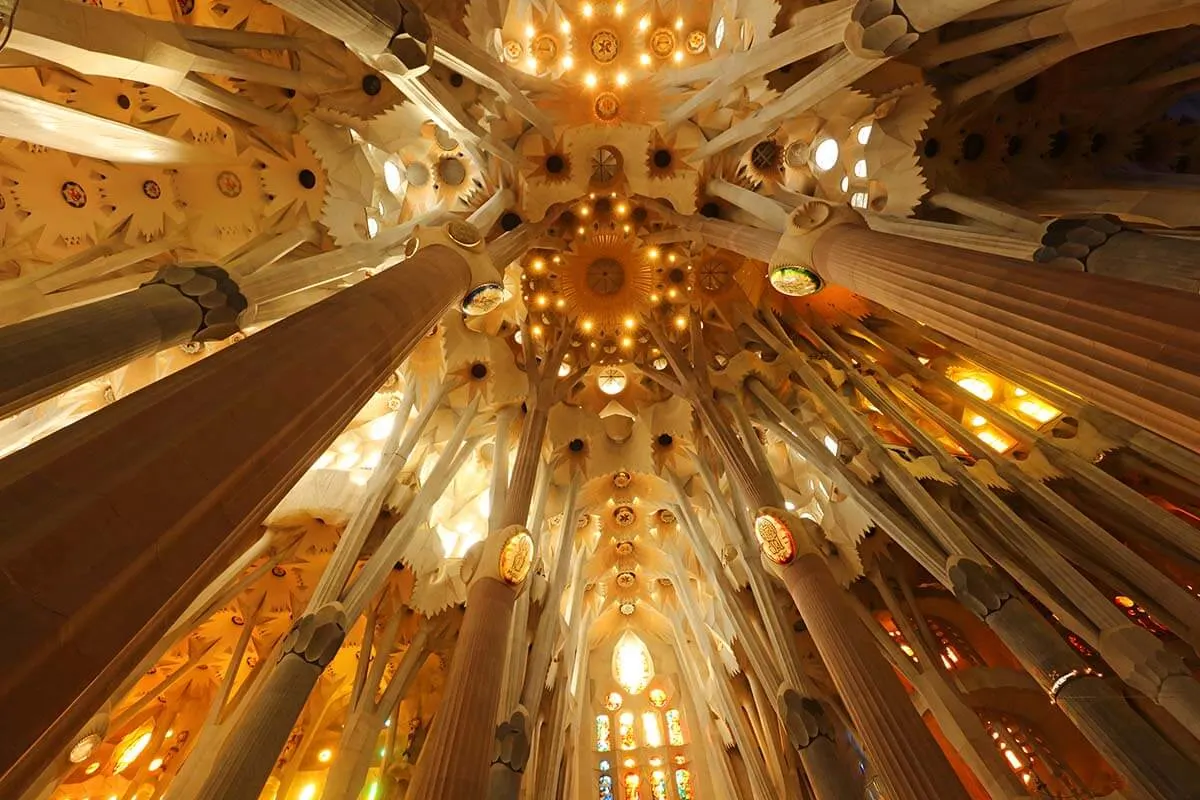
3. Feel the Soul of Sevilla
There’s a reason they say “Sevilla tiene duende” which means “Seville has a soul.” The city is the embodiment of flamenco, passion, and tradition. It’s colorful and has a strong Andalusian character. There is just something about Seville and its warm locals that will leave you looking for an excuse to return.
On top of the city’s awesome vibe, there are tons of interesting and very diverse things to do in Seville. In a way, Seville offers just as much as Madrid and even Barcelona and should be high on any Spain bucket list! You have to remember that for hundreds of years, Seville was the only city where ships could enter the country when they returned from the New World. That made it the center of commerce and wealth.
Arguably, Seville’s most impressive sight is the Royal Alcazar Palace which dates back to the Moorish times. After the Alhambra, it is the second most beautiful Moorish palace in Spain.
Right across from the Alcazar is Seville’s massive Gothic Cathedral with its Giralda Bell Tower which originally was a mosque’s minaret. The Cathedral is one of the top-3 largest Catholic churches in the world and is impressive.
You have to explore at least a few historic palatial houses and see the monumental Plaza de España and the adjacent Maria Luisa Park. And there are many other interesting places you can’t miss on a visit to Seville. But the best way to experience the true soul of Seville is by simply getting lost in some of its historic neighborhoods. Don’t miss the quaint Jewish quarter of Santa Cruz and working-class Triana, the birthplace of flamenco and home to some of the best flamenco shows.
TIP: While Seville’s winters are mild, the city gets extremely hot in the summer (it’s the warmest place in Spain!). We recommend avoiding visiting in July and August when even the locals escape the city and head to the beaches of the Andalusian coast.
READ ALSO: How to See the Best of Seville in 2 Days
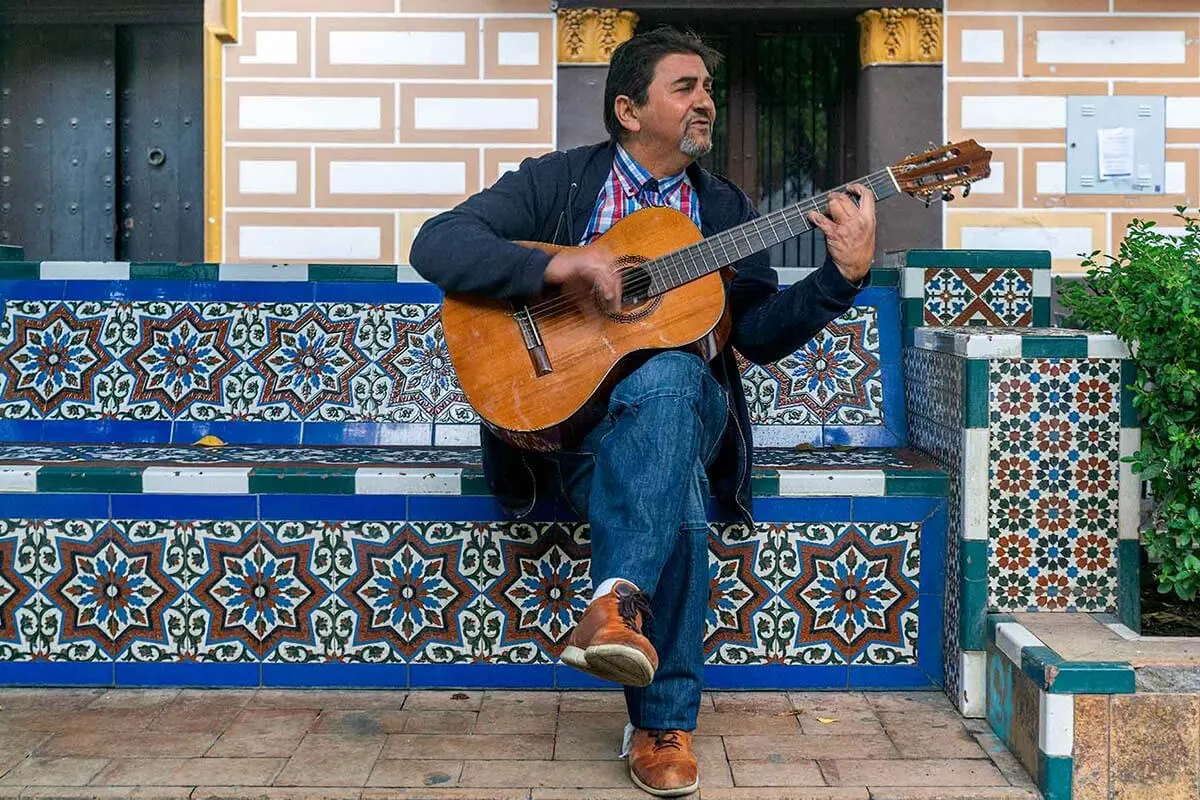
4. Discover the Charming Mallorca Island
If you are looking for a Mediterranean experience, then look no further than the largest island of the Balearics – Mallorca. The azure water is crystal clear and calm, a classic Med.
You can beach-hop around the coast, discovering intimate sandy coves surrounded by jagged rocks and pine trees. But the reason to put Mallorca on your Spain bucket list is because this island offers the complete package. Besides the incredible beaches and food, the island also has postcard-perfect villages and charming towns.
Palma de Mallorca is a must-see, of course. But one of our absolute favorites is Sóller, set next to the mountains in a green valley of orange groves. The streets of this village are lined with raw stone buildings with characteristic green shutters and windows – picture perfect. You’ll also find plenty of quaint cafes, tapas bars, and ice cream shops. You won’t want to leave…
The neighboring village of Port de Sóller just 2.5 miles away on the coast is well worth a visit too. Make sure to check it out and take a swim in its tranquil crescent bay.
TIP: Don’t go to Sóller by car. Instead, take the vintage wooden train that runs from the capital city of Palma de Mallorca. The hour-long ride is one of the most memorable experiences on the island. You will cross over valleys on stone bridges and pass through tunnels that are just barely wide enough for the wagon to fit through – all while taking in the gorgeous Mallorquín scenery.
Some other places you shouldn’t miss are Valldemossa located high in the Serra de Tramuntana mountains and the 13th-century walled village of Alcudia.
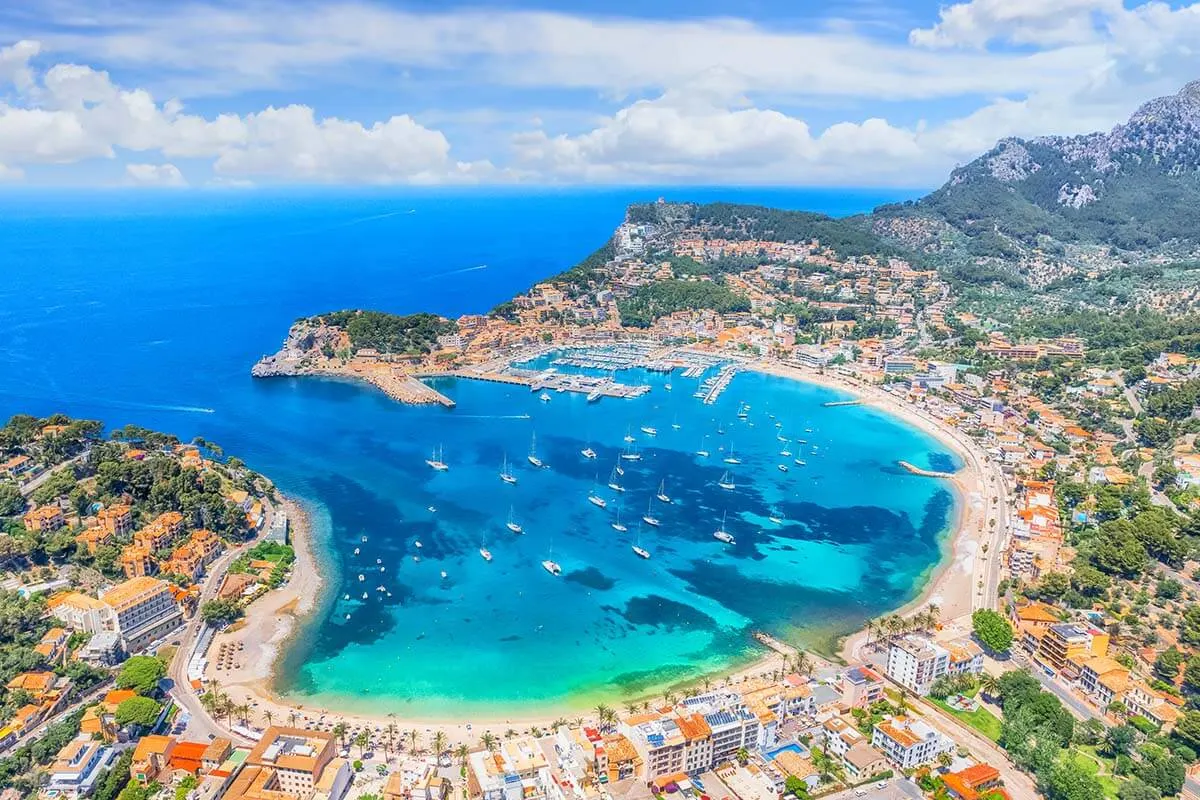
5. Enjoy Basque Food
It’s impossible to visit Spain and not taste various tapas. No matter which part of the country you visit, you’ll see that tapas are simply everywhere… But there is one region that we want to highlight more than others, and that’s the Basque Country in the North of Spain. The most popular places to visit here are Bilbao and San Sebastian.
The food from the Basque Country is considered as one of the best in the country. I would agree 1000% percent! It’s not a coincidence that the restaurants from this region have been awarded more Michelin stars per capita than anywhere else in the country.
But you don’t have to dine at fancy restaurants to have good food in the Basque Country. Good food is the status quo there. Bars even compete annually with one another for the bragging rights of having the best tapas, or pintxo as they are known locally. This competitive nature forces the chefs to step up their game and come up with some incredible bites.
PRO TIP: Visit Bilbao and San Sebastian and go on a pintxo crawl. Sample a few pintxos with a drink at one bar and then head off to the next. Once you feel as though you have been “teased” enough, then make your way to a restaurant and finish off with a full dinner.
Needless to say, there are a lot of things to do in Basque Country that merit a visit, not just the amazing food.
Good to know: The weather is not always as nice here as in the rest of Spain. There is often a constant light mist or sprinkle that comes down. The Basques even have a name for it – Txirimiri. But hey, that’s also what gives the place its delicious ingredients! Plus, if you are visiting Spain in the summer when it’s often too hot for sightseeing in many other regions, the Basque Country with its cooler temperatures is a great place to be!
READ ALSO: One Day in Bilbao

6. Admire Fine Art in Madrid
Madrid is Spain’s capital city and one of the largest in all of Europe. While it might not be as beautiful as Barcelona or Seville, it does have its fair share of areas worth checking out such as the Gran Vía, Puerta del Sol, and Plaza Mayor. Toledo day trip is also a great addition to any Spain bucket list!
But if there is one thing that you absolutely can’t miss in Madrid, it’s the “Golden Triangle of Art”, three of Europe’s best art museums.
Prado Museum has an incredible collection of Renaissance and Baroque artists such as Goya, Velázquez, El Greco, Rembrandt, Rubens, Caravaggio, and Botticelli. Its collection is one of the finest of European art in the world. If you have time to visit just one of the three, make it this one.
Reina Sofia Museum focuses mainly on modern Spanish art. The most important work is Picasso’s infamous Guernica painting, which depicts the German bombing of the town of Guernica in the Basque Country. During WWII, the painting toured worldwide and helped stir up anti-Nazi sentiment. Needless to say, Germans hated the painting and tried to have it destroyed.
Lastly, there is the Thyssen Museum. Its collection essentially fills in the historical gaps left by the other two museums. Here, you can admire the works of Van Gogh, Renoir, and Degas, among many others.
TIP: In addition, take the time to visit the Royal Palace of Madrid. This is the largest Royal Palace in Western Europe and an absolute must-see in Spain!
READ ALSO: How to See the Best of Madrid in 1 Day

7. See a Flamenco Show
Seeing a flamenco show is one of the most unique experiences in Spain. It’s just such a big part of the local culture!
Today the name “gypsy” is often seen as a politically incorrect way to refer to the Roma people scattered throughout the world. However, in Spain, this group of Roma proudly identify as gypsy or gitano as they are known in Spanish.
Since the 15th century when they first arrived over the Pyrenees mountains and into Spain, the gitanos have been leaving their mark on the country’s culture. Their biggest contribution is flamenco music and dance. It stems from Moorish and Jewish influences, mixed with their own.
Interesting to know: Flamenco culture likely originated in the caves of the Sacromonte quarter in Granada. In Seville, they’ll tell you that Flamenco originated in the Triana neighborhood. In any case, it quickly spread all over Andalusia and has since become one of the most recognizable symbols of Spanish culture.
I am the first to admit that for years I avoided seeing a flamenco show because I thought it was just a cliche tourist trap thing to do. And while it is very touristy, in many places, it’s definitely not just something they do for tourists. The performers are incredibly passionate about their craft and it just so happens that playing to packed crowds of tourists night after night is the best way for the theaters to attract the best dancers and musicians.
Flamenco is very intense and in many ways over the top, with passionate facial expressions and peacocking. But it’s captivating and absolutely contagious. After the show, you will likely want to try some flamenco dance on the way back to the hotel, screaming Olé!
TIP: Nowadays, you can find flamenco shows all over the country, including Madrid and Barcelona. But every local will agree that for the best, original experience, you have to be in the southern region of Andalusia, mainly Seville and Granada.
READ ALSO: Where to See the Best Flamenco Shows in Seville
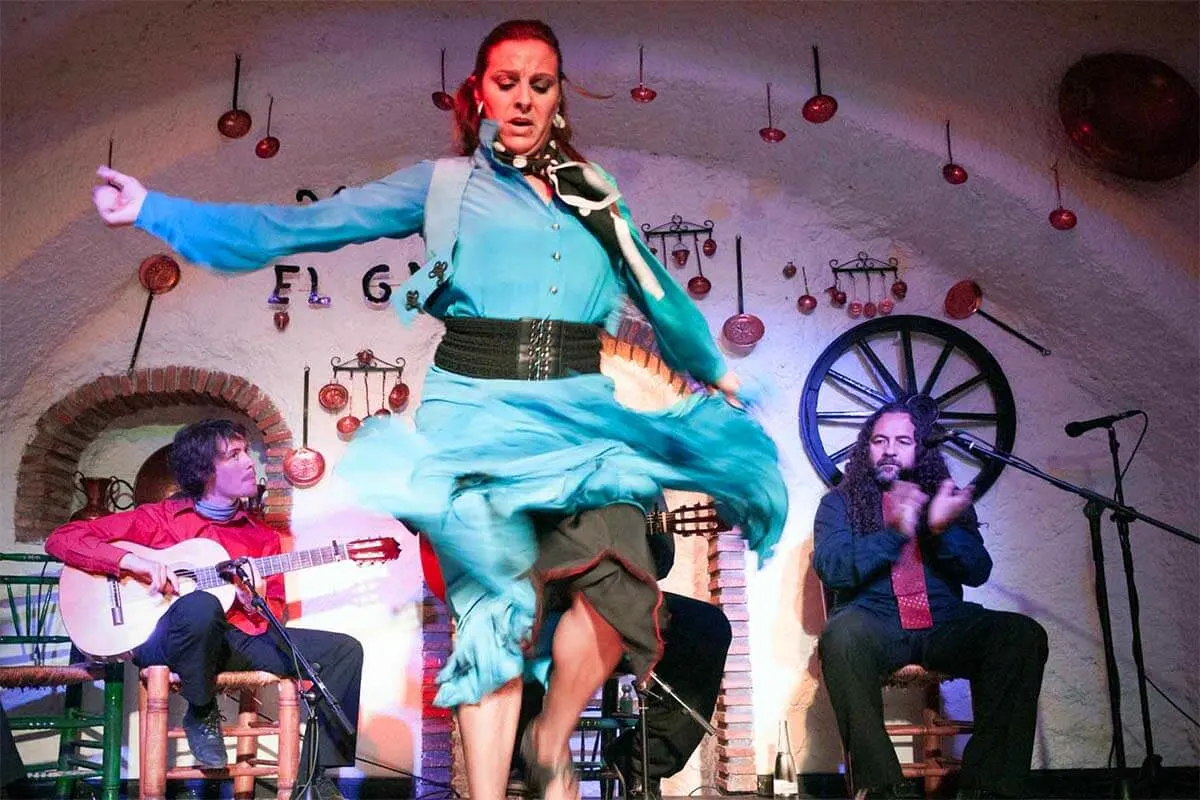
8. Get off the Beaten Path in Cabo de Gata
If you would like to explore Spain a bit deeper, beyond the main cities and landmarks, then consider visiting Cabo de Gata-Níjar National Park in Almería, south of Spain.
This arid desert landscape has 39 miles of protected coastline that is teeming with marine life. The turquoise waters are flanked by volcanic cliffs in a rainbow of colors and fossilized sand dunes.
The coast is dotted with pristine beaches, one after another. It’s easy to find your own private paradise here, and, if you feel inclined, you can even don your birthday suit – it’s very common! There’s a lot of coast and not that many people.
Besides relaxing at the beach, Cabo de Gata also offers a variety of activities such as diving, snorkeling, boat excursions, kite surfing, and ATV rides through the desert. But my favorite is renting a kayak and exploring some of the coastline that can only be accessed by water. There are even caves that you can navigate through – how cool is that?!
Good to know: Outside of Spain, Cabo de Gata is relatively unknown. So keep it secret! But if you do want to be one of the first “outsiders” to check it out, the easiest way to get there is through the Almería airport. Cheap flights can be found from Madrid, Seville, and several other Spanish cities during the summer months. All of the towns in Cabo can be reached in 30-40 min from the Almería (LEI) airport.
PRO TIP: The residents of Cabo have managed to keep out large-scale hotels and only small locally owned places can be found within the park. The coastal town of San José is the main hub with some nice accommodations and plenty of restaurants. There isn’t much nightlife, but then again, that’s not what you go to Cabo for.

9. Experience the Mosque-Cathedral of Cordoba
The Great Mosque of Cordoba, or Mezquita as it is also locally known, is one building that could be described as an “experience.” Where else have you ever even heard of a 16th-century Gothic cathedral that is built right in the middle of an 8th-century mosque?
It’s a melting pot of the best architecture of the Christian world with the best of the Muslim world, all within the same four walls – a truly bizarre sight!
Besides the crazy juxtaposition, the Mezquita is regarded as being one of the greatest mosques ever built. It is so beautiful that even the conquering Christians did not tear it down and instead converted it for use as a church.
TIP: Make sure you don’t miss the Mihrab, a prayer niche in the back. The way the gold mosaic tiles sparkle in the light is magical.

10. Enjoy the Year-round Summer in the Canary Islands
The Canary Islands are a Spanish archipelago in the Atlantic Ocean, just off the coast of Morocco and Western Sahara. Their unique location means that the islands enjoy a very mild and stable climate. With over 300 days of sunshine and average temperatures between 18 and 24 °C (64-75 °F) throughout the year, the Canaries are the perfect destination for sun-seekers.
It will come as no surprise that the Canary Islands are among the most popular beach destinations in Europe. But there’s a lot more to experience here, beyond the beaches.
Tenerife and Gran Canaria are among the largest and most popular islands, offering a wide variety of things to do. From volcanic interior to sandy beaches and from quiet villages to bustling resorts, there’s truly something for everyone here.
Fuerteventura has some of the best beaches in the archipelago and is a popular place for all kinds of wind sports. Lanzarote has beautiful beaches too but is best known for its volcanic landscapes characterized by dramatic lava fields, rugged coastlines, and unique rock formations.
La Palma offers jaw-dropping mountain scenery, a bit like the nearby Portuguese island Madeira. One of the smaller islands, La Graciosa, is also less developed – perfect for those looking for a more secluded vacation.
No matter which one you choose, the Canary Islands will enchant you with their natural beauty, rich history, and warm, welcoming culture. Whether you are looking for a relaxing vacation or adventure, these islands have something magical for everyone.
TIP: If you can, avoid visiting during the peak seasons (=European school holidays) – it will be so much quieter and more enjoyable. Also, if you are interested in hiking and outdoor adventures, it’s best to avoid the warmest summer months. Despite the mild climate, it can sometimes get quite hot in July and August.
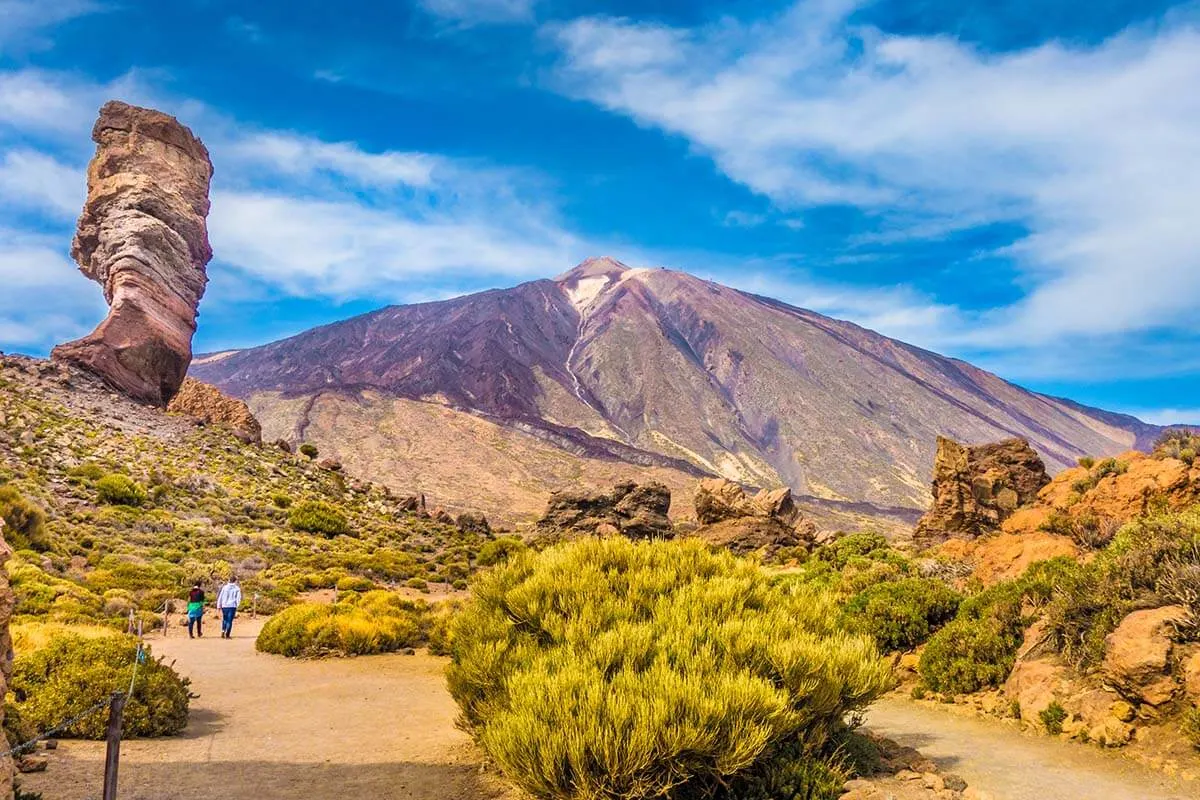
11. Indulge in Rioja Wines
Spain may not be as known for its wines as much as its neighbors of France and Italy, but its wines are world-class. The most famous of them all is the wine from the La Rioja region.
Contrary to popular belief, Rioja does not refer to it being a red wine – red is “rojo” in Spanish but when referring to red wine it is actually “tinto”. Anyway, Rioja is simply the name of the wine region of Northern Spain. In fact, La Rioja borders the earlier-mentioned Basque Country, which makes it the perfect destination for all food- and wine lovers.
There are over 500 wineries in Rioja, from small, family-owned wineries to large modern ones. Some of the most famous wineries with extraordinary design include the Tondonia Winery Pavilion designed by Zaha Hadid, Ysios Winery designed by Santiago Calatrava, and Winery/Hotel Marqués de Riscal by the famous contemporary architect Frank Gehry.
Rioja wines are usually red and they primarily use Tempranillo grapes which are the most popular in Spain. All over the country wines are typically categorized as Crianza, meaning they have spent one year in oak barrels, Reserva, meaning they have aged for 3 1/2 years, and Gran Reserva which is around 5 years. With age, the flavor gets stronger and bolder.
Good to know: La Rioja region has more to offer than just its wines and is an amazing place to visit, especially around the walled village of Laguardia where military tunnels were converted into wine cellars many hundreds of years ago. The region is also known for some extravagant modern architecture. There are also wine/architecture tours that bring you to all the top places in the area and allow you to enjoy wines without having to worry about driving.
TIP: If you can’t make it to La Rioja for a food and wine trip, you will find Rioja wines all over Spain. Of course, you may want to try wines from other regions too, but if you like a quality wine without bad surprises, then you can’t go wrong with a Rioja.
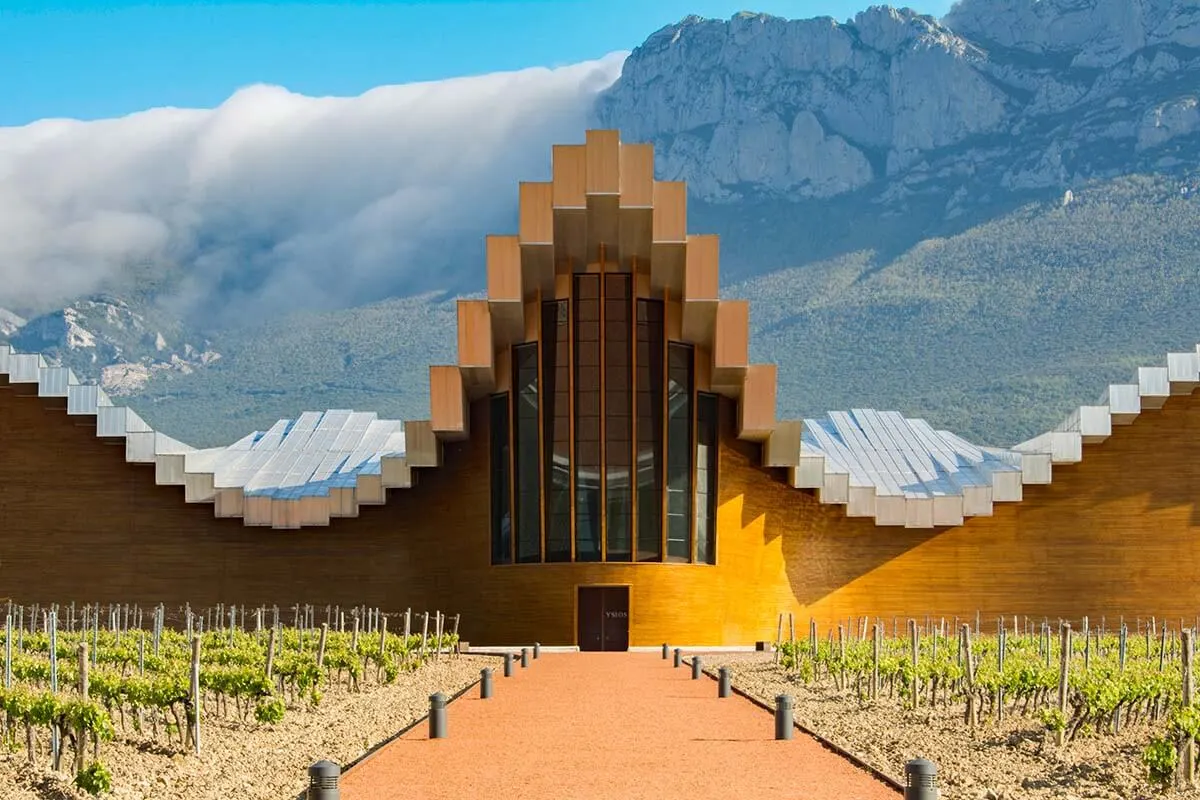
So, this is our guide to some of the best experiences in Spain. As you can see, there are so many reasons to visit!
To some, Spain is the ultimate vacation destination, a land that is known for its siestas and where no one is in a rush. A place where the locals feast on giant pans of paella that could feed an entire village. And of course, everyone dances flamenco to burn off all those tasty tapas… While those stereotypes do not paint an accurate picture of what Spain is, they do hold some truth. Spaniards are very social and are known for enjoying life.
Many people also travel to Spain for its cities, fascinating architecture, and unique cultural experiences. Some others visit for its historical buildings and relics from past civilizations. Indeed, you will find Celtic, Roman, Greek, and Moorish influences…
Spain’s diversity can also be seen in its weather and landscapes. The south is very dry and much of it is even desert-like. In the meantime, the north is wet and green. Even the language in Spain is diverse. Besides huge regional differences in dialects, there are even completely different languages…
TIP: So if there’s one tip we can give you when you plan your first trip, try to visit a couple of different parts of the country, even if just for a few days each. Regardless of where you go, you’ll find a combination of interesting landmarks, beautiful architecture, good food and drink, and warm locals. At the same time, you will also discover unique features of different regions and that will make your trip so much more memorable.
READ ALSO: How to Plan a Trip to Europe
More tips for your trip to Spain:
- Barcelona:
- Madrid:
- Seville:
If you found this post helpful, don’t forget to bookmark it and share it with your friends. Are you on Pinterest? Pin these images!

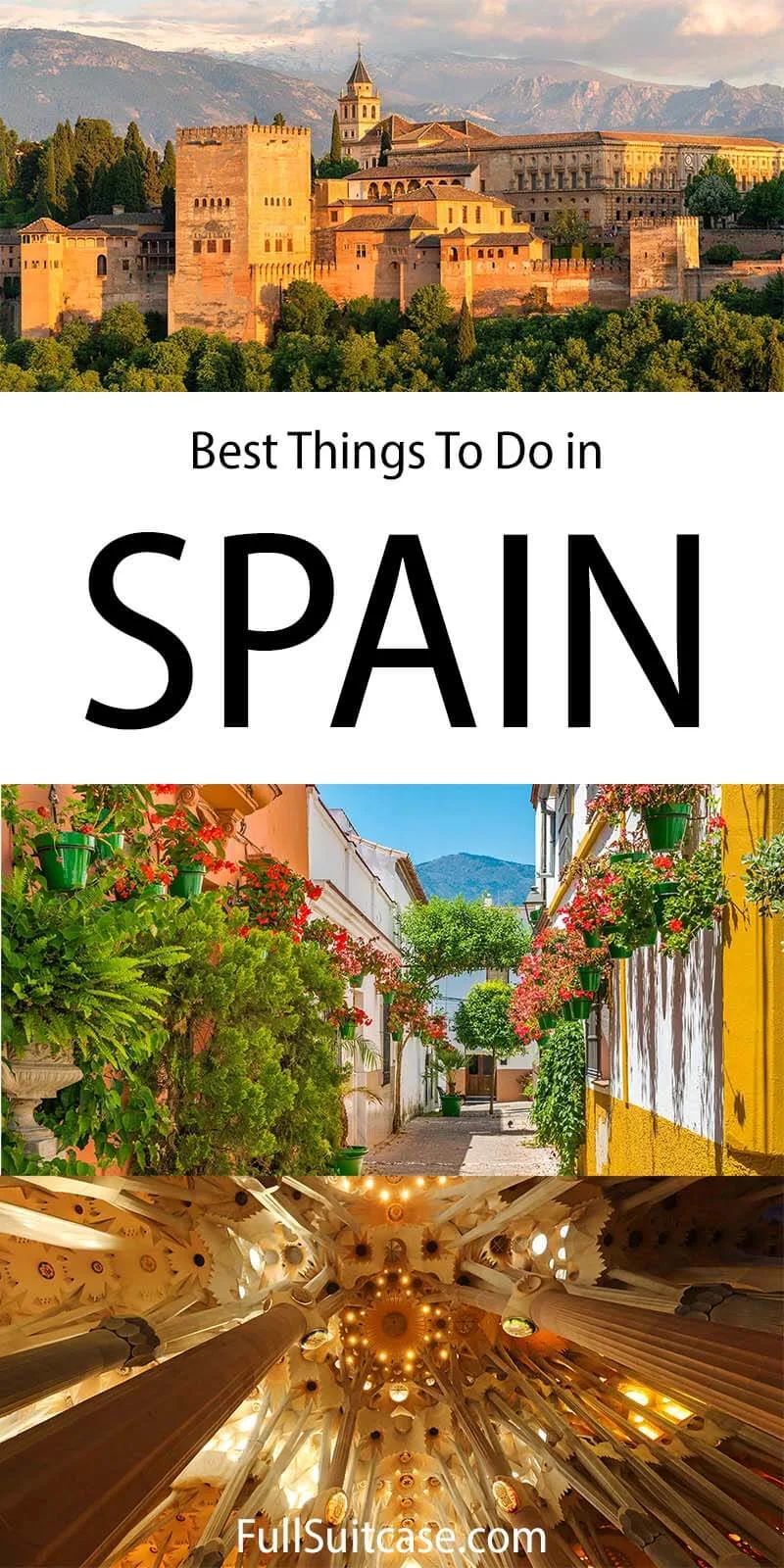
Images: personal collection, Patricia Palacios, and giuseppemasci/Depositphotos.com.

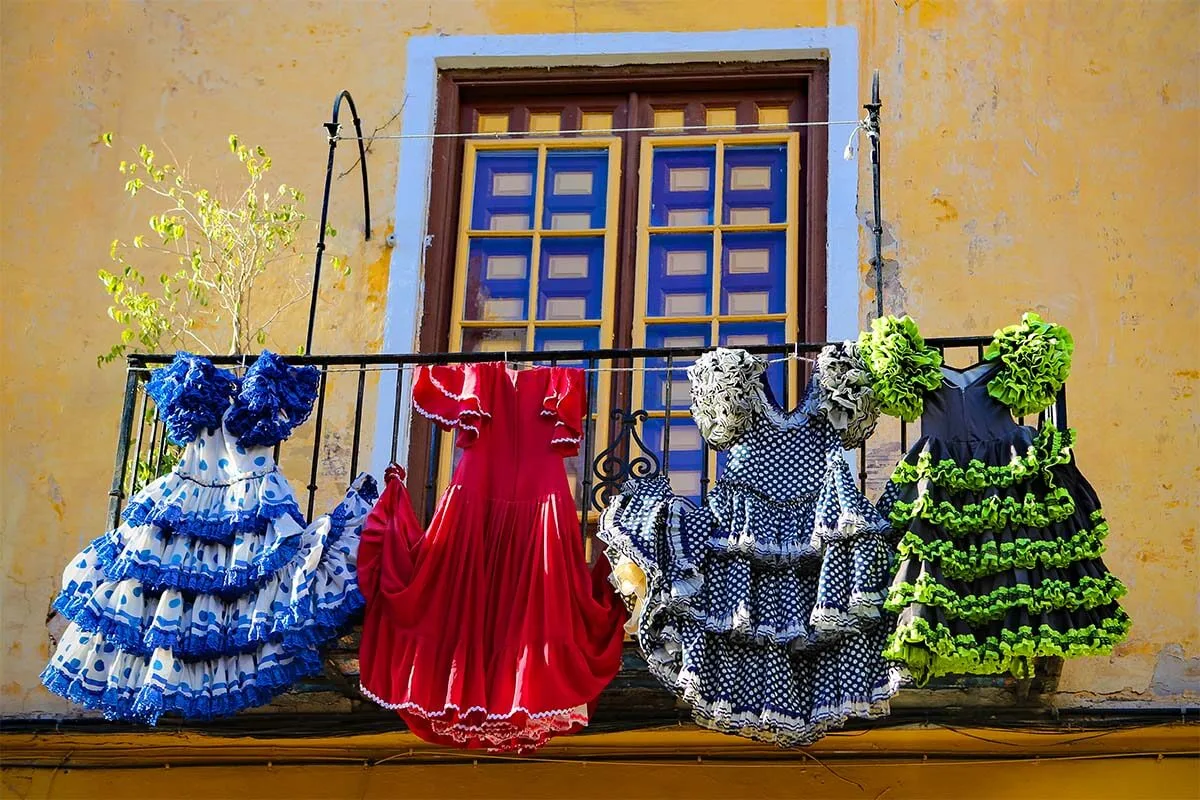
dixie fleege
Thursday 25th of January 2024
I am getting so excited about Spain!!! What do you think about 2 older women driving around Spain or taking the train? I’m happy to see these different places I never heard of and being a historian you have a rich history of the Moors and the Catholic Church. Also we are going to Spain in September, do you think 3 weeks is a rather reasonable timeframe to see most of Spain?
Jurga
Thursday 25th of January 2024
Hi Dixie, Spain is huge and has a lot to offer. So before deciding how you'll travel around, you should decide which places you'll visit. For very long distances (or if you want to visit some of the islands), it's more convenient to fly, otherwise if you are mainly interested in cities, you can just take a train. Renting a car is also ok, but only do it for the areas where you'll be spending most of your time outside of cities. And yes, you can see a lot in three weeks, especially if you just stay on the mainland. You won't see 'most' of Spain, but with some good planning, you can definitely see the main highlights. For example, you could visit the following places: * Barcelona area (5-6 days including a few day trips like Girona and Montserrat Monastery). * Train to Valencia (3-4 days there). * Train to Madrid (3-4 days in that area, including Toledo). * Train to Seville (2-3 days in the city). + 3-10 days Andalusia road trip by car or visit the main places (Granada, Cordoba, etc.) by train and potentially also book guided tours to some smaller towns/villages. + In the north, you could add Bilbao and the Basque Country region to this itinerary. Or stay longer in the south and visit Gibraltar, maybe even take a 1-2 days trip to Tangier, Morocco. You can also add a few days of beach/sightseeing holiday at one of the islands, like Mallorca which is great in September.
There are so many ways to plan a trip and dozens of options everywhere. So pick the places that interest you, take a map, and see how you can fit it all together. TIP: Use Google Maps for planning. If you choose a little train icon, you can see public transport options (e.g. how long the train takes). Good luck!